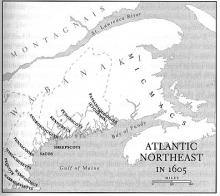Penobscot Bay and Midcoast Maine

Maine has extensive shoreline, natural harbors, rivers, and waterfalls, and water played a big role in the development of our state. Early settlers in Maine relied on water for transportation, power, and fish. Since agriculture was limited by poor soil and a short growing season, settlers naturally turned to Maine’s rich natural resources for their own needs and for trade.
Consequently, as towns developed, they were widely scattered. Many occupations were, and still are, seasonal. Maine’s location and natural features have contributed to its traditional eastward orientation, even in the 19th century when the rest of the country was focusing on westward expansion.
Maritime communities had more connections to the broader world than inland towns. Residents of coastal towns were exposed to sailors from many countries, goods from a variety of ports, letters home from family members at sea, and opportunities to travel by water. Today, everyone is connected by rapid transportation, computers, and the media, but between the 17th and early 19th centuries, knowledge of the world and access to other cultures largely depended on proximity to the water.
What is a maritime community? It is a group of people that together support and implement the business of the sea and depend on it for many aspects of their lives. Community members work on the water or help make it possible for others to do so. The sea is directly or indirectly responsible for their prosperity or lack of wealth and for their access to the wider world.

